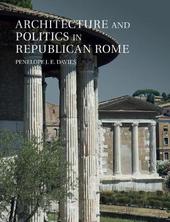
|
Architecture and Politics in Republican Rome
Paperback / softback
Main Details
| Title |
Architecture and Politics in Republican Rome
|
| Authors and Contributors |
By (author) Penelope J. E. Davies
|
| Physical Properties |
| Format:Paperback / softback | | Pages:376 | | Dimensions(mm): Height 278,Width 217 |
|
| Category/Genre | Ancient and classical art BCE to c 500 CE
Architecture
Classical Greek and Roman archaeology |
|---|
| ISBN/Barcode |
9781107476110
|
| Classifications | Dewey:720.103 |
|---|
| Audience | | Professional & Vocational | |
|---|
| Illustrations |
18 Maps; 198 Halftones, color; 12 Halftones, black and white; 2 Line drawings, color; 33 Line drawings, black and white
|
|
Publishing Details |
| Publisher |
Cambridge University Press
|
| Imprint |
Cambridge University Press
|
| Publication Date |
9 June 2020 |
| Publication Country |
United Kingdom
|
Description
Architecture and Politics in Republican Rome is the first book to explore the intersection between Roman Republican building practices and politics (c.509-44 BCE). At the start of the period, architectural commissions were carefully controlled by the political system; by the end, buildings were so widely exploited and so rhetorically powerful that Cassius Dio cited abuse of visual culture among the reasons that propelled Julius Caesar's colleagues to murder him in order to safeguard the Republic. In an engaging and wide-ranging text, Penelope J. E. Davies traces the journey between these two points, as politicians developed strategies to manoeuver within the system's constraints. She also explores the urban development and image of Rome, setting out formal aspects of different types of architecture and technological advances such as the mastery of concrete. Elucidating a rich corpus of buildings that have been poorly understand, Davies demonstrates that Republican architecture was much more than a formal precursor to that of imperial Rome.
Author Biography
Penelope J. E. Davies is Associate Professor in the Department of Art and Art History at the University of Texas, Austin. She earned her PhD in Classical Archaeology from Yale University, Connecticut. Her work focuses on public monuments of Rome and their propagandistic functions. Author of Death and the Emperor: Roman Imperial Funerary Monuments from Augustus to Marcus Aurelius (Cambridge, 2000), she also co-authored Janson's History of Art, 7th and 8th editions (2006, 2011).
Reviews'In this perceptive book Davies interrogates the evolving, mutually exploitative exchange between architecture and politics in Rome of the Republic. Drawing on deep research, she expertly reveals how such factors as term limits, religious traditions, materials, and cultural shifts constrained and enriched politicians and architectural projects alike. It is an informative and compelling story, told with verve and insight.' Diane Favro, University of California, Los Angeles 'Davies' achievement is to stand above the topographical fray and to keep the focus at all points on the bigger picture of historical context. The consequence is a volume that is truly innovative. We have seen many volumes on Roman Republican history with only glancing reference to architecture, and some (but not many) on Republican Art and Architecture, with only generic reference to historical context. What Architecture and Politics in Republican Rome achieves is to pull together these story lines into an integrated narrative that is so persuasive we may ask ourselves why it has never been done before.' Andrew Wallace-Hadrill, University of Cambridge 'Davies provides what amounts to a definitive architectural history of republican Rome (509-44 BCE). Distinguishing this volume from previous treatments is not only Davies's comprehensive approach and skilled integration of historical sources alongside presentation of the monuments, but also her inclusion of state-of-the-art illustrations, among them phase plans, digital reconstructions, and photographs, most reproduced in color. What emerges is a gradually evolving urban fabric for the city, one realized not by overarching designs, but rather by piecemeal agency and accretion, prior to the grand integrative schemes imposed during the imperial period. The temples, public spaces, fortifications, theaters, and other monuments that progressively defined the cityscape of Rome during the four centuries of the Republic not only overlay the fortunes of the metropolis itself but reflect the power struggles of class and men of action, culminating in the civil wars and accompanying Rome's transformation to the Empire.' Choice
|